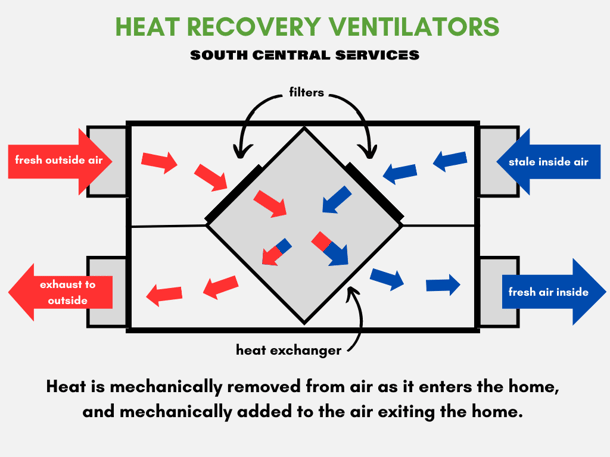The All-Inclusive Guide to the Uses of Heat Recovery Ventilation in Modern Buildings
Heat Recovery Ventilation (HRV) systems stand for a considerable advancement in developing innovation (HRV Heat Recovery Ventilation). They provide an approach for trading stagnant indoor air with fresh exterior air while reducing energy loss. This method not just enhances indoor air top quality however additionally adds to power effectiveness in both residential and industrial buildings. Comprehending the various applications and benefits of HRV can reveal its important role in contemporary style and sustainability efforts. The effects of this technology deserve exploring additionally
Recognizing Heat Recovery Ventilation Systems

Although several contemporary structures prioritize energy efficiency, comprehending warm recovery ventilation (HRV) systems is important for maximizing interior air quality and reducing energy consumption. HRV systems function by moving warm from stale interior air to inbound fresh air, efficiently keeping comfy indoor temperature levels while decreasing power loss. These systems include a warm exchanger, fans, and ductwork that assist in the blood circulation of air. During winter, HRV units catch and recycle warm from the outbound air, while in summer season, they can help cool down incoming air. By continually exchanging air, HRV systems additionally decrease moisture and the concentration of indoor pollutants. Correct installation and maintenance of HRV systems are necessary for their efficiency and effectiveness in enhancing general structure performance and convenience.
Benefits of Heat Recovery Ventilation
Heat recovery ventilation systems offer many advantages that boost both power effectiveness and indoor air high quality in modern-day buildings. By catching and reusing energy from exhaust air, these systems substantially lower home heating and air conditioning prices, causing reduced energy consumption. They preserve a consistent circulation of fresh outdoor air, minimizing the threat of indoor air contaminants and irritants. This continuous exchange aids manage moisture levels, avoiding mold and mildew development and ensuring a much healthier living atmosphere. Furthermore, HRV systems contribute to sustainability objectives by decreasing overall carbon footprints. Their ability to optimize air flow without sacrificing thermal comfort makes them a valuable addition to contemporary building design, advertising both economic and environmental benefits.
Applications of HRV in Residential Structures
As homeowners increasingly prioritize energy effectiveness and indoor air high quality, the applications of warm healing air flow (HRV) systems in residential buildings have become much more widespread. HRV systems are particularly helpful in firmly secured homes, where maintaining fresh air flow is vital for protecting against wetness buildup and indoor toxins. They effectively transfer warmth from outbound stagnant air to inbound fresh air, reducing power prices connected with cooling and heating. In addition, HRVs can improve comfort levels by regulating humidity and temperature. They are also adaptable for various household layouts, including single-family homes and multi-unit buildings. In general, incorporating HRV systems supports lasting this content living practices while making sure a much healthier indoor environment for residents.
HRV in Commercial and Industrial Setups
In business and commercial settings, the implementation of heat healing air flow (HRV) systems has actually come to be progressively critical for optimizing power efficiency and maintaining air top quality. These systems successfully transfer heat from exhaust air to inbound fresh air, minimizing the demand for extra home heating or cooling. This not just reduces power prices but also adds to sustainability efforts. Industries such as production, warehousing, and office complex benefit substantially from HRV systems, as they aid control temperature and moisture degrees, making sure a comfy and productive atmosphere. HRV systems aid in removing contaminants and excess wetness, boosting interior air top quality. As policies around air high quality end up being more stringent, the adoption of HRV technology is most likely to grow, making it a critical element of modern-day commercial and commercial infrastructure.
Future Patterns in Heat Recovery Ventilation Modern Technology

Regularly Asked Inquiries
Just How Does Heat Recovery Ventilation Effect Indoor Air Top Quality?
Heat recovery ventilation considerably improves indoor try here air high quality by continually websites trading stale interior air with fresh outdoor air while recouping power. This process decreases pollutants, preserves ideal moisture levels, and guarantees a much healthier atmosphere for residents.
Can HRV Equipments Be Set Up in Existing Structures?
HRV systems can without a doubt be installed in existing buildings. Retrofitting might require modifications to ductwork and air flow designs, yet it significantly boosts power performance and indoor air high quality, making it a viable choice for older frameworks.
What Upkeep Is Needed for HRV Systems?

Exist Specific Climates Where HRV Is A Lot More Effective?
Heat recovery ventilation systems are especially efficient in climates with significant temperature differences between seasons. These systems enhance power efficiency by recovering warmth from exhaust air, making them excellent for both cold and moderately cozy environments.
Exactly How Do HRV Systems Affect Energy Expenses?
